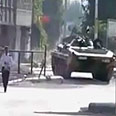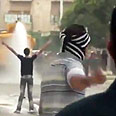

Syria's army suspended days of punishing attacks on the restive city of Homs and began withdrawing its tanks Tuesday just as Arab League monitors visited the area and met with local leaders, activists and officials said.
The British-based activist group Syrian Observatory for Human Rights said as the monitors visited Homs, at least 20,000 protesters gathered in some neighborhoods to "reveal the crimes committed by the regime."
Related stories:
- 'Syria crackdown is mass destruction'
- Arab monitors due in Syria as violence flares
- UN condemns Syria terrorist attacks
About 60 Arab monitors - the first Syria's regime has allowed in during its nine-month crackdown on an anti-government uprising - arrived Monday night and began work Tuesday. The withdrawal from Homs was the first tangible sign that President Bashar Assad was implementing the terms of the Arab League plan to halt attacks that overwhelmingly target unarmed, peaceful protesters. The monitors are supposed to ensure the government complies with the deal .
After signing on to the plan early last week, Assad's regime only appeared to be intensifying the crackdown, rather than easing up, and it was condemned internationally for flouting the agreement. On Monday, security forces killed at least 42 people, most of them in Homs.
Opposition activist Mohammed Saleh said the heavy bombardment of Homs stopped in the morning and tanks were seen pulling out. Another Homs-based activist said he saw armored vehicles leaving early on a highway leading to the city of Palmyra to the east. He asked that his name not be made public for fear of retribution.
"Today is calm, unlike pervious days," Saleh said. "The shelling went on for days, but yesterday was terrible."
The British-based Syrian Observatory for Human Rights said some army vehicles pulled out of Homs while other relocated in government compounds "where (they) can deploy again within five minutes."
A local official in Homs told The Associated Press that the team of monitors met with Ghassan Abdul-Aal, the governor of Homs province. After the meeting, the monitors headed to the tense districts of Baba Amr and Inshaat, which have witnessed the most intense crackdowns since Friday.
Military forces had pounded Homs with artillery for days.
Opposition slams Arab deal
Given the intensified crackdown, the opposition sees Syria's agreement to the Arab League plan as a farce, and some even accuse the League of complicity in the killings. Since Syria signed on to the deal on Dec. 19, activists said nearly 300 civilians have been killed. About 150 more died in clashes between army defectors and troops - most of them defectors.
Syria's conflict is becoming increasingly militarized with military defectors mounting armed resistance.
The Arab League plan demands the government remove its security forces and heavy weapons from city streets, start talks with opposition leaders and allow human rights workers and journalists into the country. Before Tuesday's redeployment of at least some tanks, there had been no sign that Assad was implementing any of the terms, much less letting up on his brutal crackdown.
Opponents of Assad doubt the Arab League can budge the autocratic leader at the head of one of the Middle East's most repressive regimes. Syria's top opposition leader Burhan Ghalioun called Sunday for the League to bring the UN Security Council into the effort. The UN says more than 5,000 people have been killed since March in the political violence.
In Cairo, an official at the Arab League's operations room said the Sudanese head of the mission to Syria, Gen. Mohamed Ahmed Mustafa al-Dabi, was leading the team of at least 12 observers to Homs. The official spoke on condition of anonymity because he was not authorized to speak to journalists.
Homs, Syria's third largest city, has a population of 800,000 and is at the epicenter of the revolt against Assad. It is about 100 miles (160 kilometers) north of the capital, Damascus. Many Syrians refer to Homs as the "Capital of the Revolution."
Also in Homs, the local official said that before dawn Tuesday, a bomb targeted a gas pipeline in the city, the third such attack within a month. The official, who spoke on condition of anonymity because he was not authorized to speak to the media, said the pipeline carries gas from fields east of Homs to a power station in the central province of Hama.
- Receive Ynetnews updates
directly to your desktop















